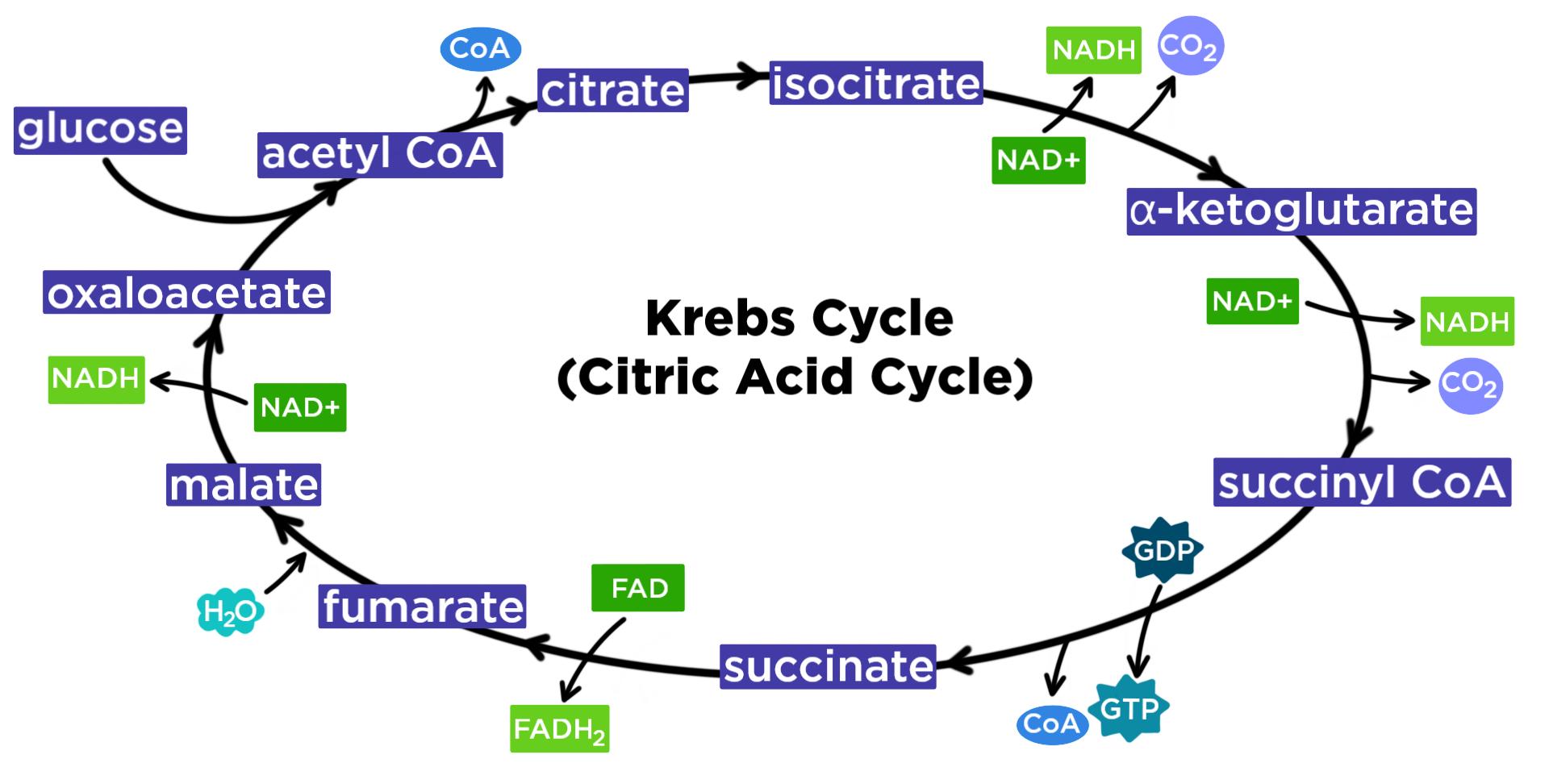
The Krebs Cycle, also known as the Citric Acid Cycle or the Tricarboxylic Acid Cycle, is a fundamental metabolic pathway that plays a crucial role in generating energy for cells. Named after its discoverer, Sir Hans Krebs, this cycle is an intricate series of chemical reactions that take place within the mitochondria of eukaryotic cells.In this article, we will delve into the fascinating world of the Krebs Cycle and uncover twelve intriguing facts about its significance, mechanism, and regulation. From its role in the breakdown of carbohydrates, fats, and proteins to its involvement in the production of ATP, the primary energy currency of cells, the Krebs Cycle is a vital component of cellular respiration.So, let’s embark on this journey of discovery and unravel the mysteries surrounding the Krebs Cycle, shedding light on its intricate workings and highlighting its importance in the complex web of biological processes.
Key Takeaways:
- The Krebs Cycle, also known as the Citric Acid Cycle, is a crucial process that converts nutrients into energy-rich molecules called ATP, essential for our body’s functions.
- This cycle, discovered by Hans Krebs, takes place in the mitochondria and produces high-energy molecules while also playing a key role in biosynthesis and aerobic endurance.
Fascinating The Krebs Cycle is a central metabolic pathway.
The Krebs Cycle, also known as the Citric Acid Cycle, is an essential part of cellular respiration in all aerobic organisms. It plays a central role in converting nutrients, such as carbohydrates, fats, and proteins, into energy-rich molecules called ATP.
Interesting It was discovered by Hans Krebs in 1937.
The Krebs Cycle was named after the German biochemist Hans Krebs, who elucidated the steps of this metabolic pathway in His groundbreaking research shed light on the complex mechanisms involved in energy production within cells.
Engaging It takes place in the mitochondria.
The Krebs Cycle occurs within the mitochondria, which are often referred to as the “powerhouses” of the cell. These specialized organelles are responsible for generating the majority of ATP required for cellular functions.
Curious The Krebs Cycle produces high-energy molecules.
During each round of the Krebs Cycle, multiple reactions occur, leading to the production of energy-rich molecules, including NADH, FADH2, and ATP. These molecules serve as crucial sources of energy for various biochemical processes in the body.
Intriguing It involves a series of enzymatic reactions.
The Krebs Cycle consists of eight consecutive enzymatic reactions. Each reaction is catalyzed by a specific enzyme, resulting in the stepwise breakdown of acetyl-CoA and the release of energy-rich electrons and substrates.
Fascinating It is an oxidative process.
The Krebs Cycle is considered an oxidative process because it involves the removal of high-energy electrons from carbon compounds. These electrons are then transported to the electron transport chain, where they ultimately contribute to ATP synthesis.
Interesting It produces carbon dioxide as a waste product.
As carbon compounds are broken down in the Krebs Cycle, carbon dioxide is released as a waste product. This CO2 is a byproduct of the decarboxylation reactions that occur during the cycle.
Engaging The Krebs Cycle is a cyclical pathway.
Unlike linear metabolic pathways, the Krebs Cycle is a cyclical process. The end product of the cycle, oxaloacetate, is regenerated during each round, allowing for the continuous breakdown of acetyl-CoA and the sustained production of energy.
Curious It plays a crucial role in biosynthesis.
Besides ATP generation, the Krebs Cycle provides the precursors necessary for the biosynthesis of various molecules, including amino acids, nucleotides, and lipids. These building blocks are vital for cell growth and maintenance.
Intriguing The Krebs Cycle is regulated by feedback inhibition.
The activity of certain enzymes within the Krebs Cycle is regulated by feedback inhibition. High levels of ATP and NADH can inhibit key enzymes, helping to maintain metabolic balance and prevent energy wastage.
Fascinating It is interconnected with other metabolic pathways.
The Krebs Cycle is interconnected with various metabolic pathways, including glycolysis and the electron transport chain. These pathways work together to efficiently extract energy from nutrients and ensure the proper functioning of cellular metabolism.
Interesting The Krebs Cycle is essential for aerobic endurance.
The efficient functioning of the Krebs Cycle is crucial for athletes and individuals engaged in prolonged aerobic activities. It provides a continuous supply of ATP, allowing the muscles to sustain prolonged activity without fatigue.
In conclusion, the 12 Intriguing Facts About Krebs Cycle (Citric Acid Cycle) showcase the significance of this metabolic pathway in energy production and cellular metabolism. From its discovery by Hans Krebs to its vital role in producing ATP and supporting biosynthesis, the Krebs Cycle plays a fundamental role in maintaining the energy balance within living organisms.
Conclusion
In conclusion, the Krebs cycle, also known as the Citric Acid Cycle, is a crucial process that takes place in the mitochondria of cells. It plays a significant role in energy production by converting the products of glycolysis into ATP, the main energy currency of the cell. The cycle also generates important intermediates that are used in other metabolic pathways, including the synthesis of amino acids, fatty acids, and nucleotides.Understanding the intricacies of the Krebs cycle helps us appreciate the complexity of cellular metabolism and its role in sustaining life. This cycle exemplifies the elegant interplay between various enzymatic reactions and serves as a key component of aerobic respiration.The 12 intriguing facts about the Krebs cycle presented in this article shed light on its importance and provide a deeper appreciation for the remarkable processes that occur within our cells. By expanding our knowledge of this fundamental biological process, we gain a greater understanding of the intricate mechanisms that drive life itself.
FAQs
1. What is the Krebs cycle?
The Krebs cycle, also known as the Citric Acid Cycle, is a series of chemical reactions that occur in the mitochondria of cells. It plays a key role in the process of aerobic respiration by converting the products of glycolysis into energy-rich molecules.
2. Why is the Krebs cycle important?
The Krebs cycle is essential for energy production. It generates ATP, which is the main energy currency of the cell. Additionally, it produces intermediates that are used in the synthesis of other important molecules, such as amino acids and lipids.
3. How does the Krebs cycle work?
The Krebs cycle begins with the conversion of pyruvate, a product of glycolysis, into acetyl-CoA. Acetyl-CoA then enters the cycle and undergoes a series of reactions that generate ATP, carbon dioxide, and high-energy electrons. These electrons are used in the electron transport chain to produce more ATP.
4. Where does the Krebs cycle take place?
The Krebs cycle takes place in the mitochondria of eukaryotic cells. It occurs in the mitochondrial matrix, which is the innermost compartment of the mitochondrion.
5. What are the key molecules involved in the Krebs cycle?
The key molecules involved in the Krebs cycle include acetyl-CoA, oxaloacetate, citrate, isocitrate, alpha-ketoglutarate, succinyl-CoA, succinate, fumarate, malate, and oxaloacetate.
6. Is the Krebs cycle an aerobic or anaerobic process?
The Krebs cycle is an aerobic process, meaning it requires oxygen to function. Oxygen serves as the final electron acceptor in the electron transport chain, which is linked to the Krebs cycle.
7. Can the Krebs cycle occur without oxygen?
No, the Krebs cycle cannot occur without oxygen. Without oxygen, the electron transport chain cannot function effectively, leading to a buildup of intermediates in the Krebs cycle and a decrease in ATP production.
8. Can the Krebs cycle be inhibited?
Yes, the Krebs cycle can be inhibited by various factors, such as high levels of ATP or high concentrations of certain molecules. Inhibition of the Krebs cycle can disrupt cellular metabolism and lead to metabolic diseases.
9. Who discovered the Krebs cycle?
The Krebs cycle was discovered by a British biochemist named Sir Hans Adolf Krebs in the 1930s. His discovery laid the foundation for understanding cellular respiration and earned him the Nobel Prize in Physiology or Medicine in 1953.
10. Are there any diseases associated with the Krebs cycle?
Yes, mutations or deficiencies in enzymes involved in the Krebs cycle can lead to various metabolic disorders. For example, deficiencies in succinate dehydrogenase can result in Leigh syndrome, a severe neurological disorder.
11. Are all organisms capable of performing the Krebs cycle?
No, not all organisms are capable of performing the Krebs cycle. It is primarily found in aerobically respiring organisms, such as animals, plants, and fungi. Some anaerobic organisms have alternative metabolic pathways.
12. Can the Krebs cycle be regulated?
Yes, the Krebs cycle is tightly regulated by various factors, including the availability of substrates, enzyme activity, and product inhibition. This regulation ensures that the cycle operates efficiently and responds to the energy needs of the cell.
Delving into the fascinating world of the Krebs Cycle is just the beginning of your journey through the captivating realm of life sciences. Uncover more intriguing biochemistry facts that will leave you in awe of the complex processes occurring within living organisms. Explore the powerhouses of the cell, mitochondria, and learn about their crucial role in energy production. Finally, gain a deeper understanding of the intricate workings of metabolism and how it sustains life in all its forms.
Was this page helpful?
Our commitment to delivering trustworthy and engaging content is at the heart of what we do. Each fact on our site is contributed by real users like you, bringing a wealth of diverse insights and information. To ensure the highest standards of accuracy and reliability, our dedicated editors meticulously review each submission. This process guarantees that the facts we share are not only fascinating but also credible. Trust in our commitment to quality and authenticity as you explore and learn with us.


